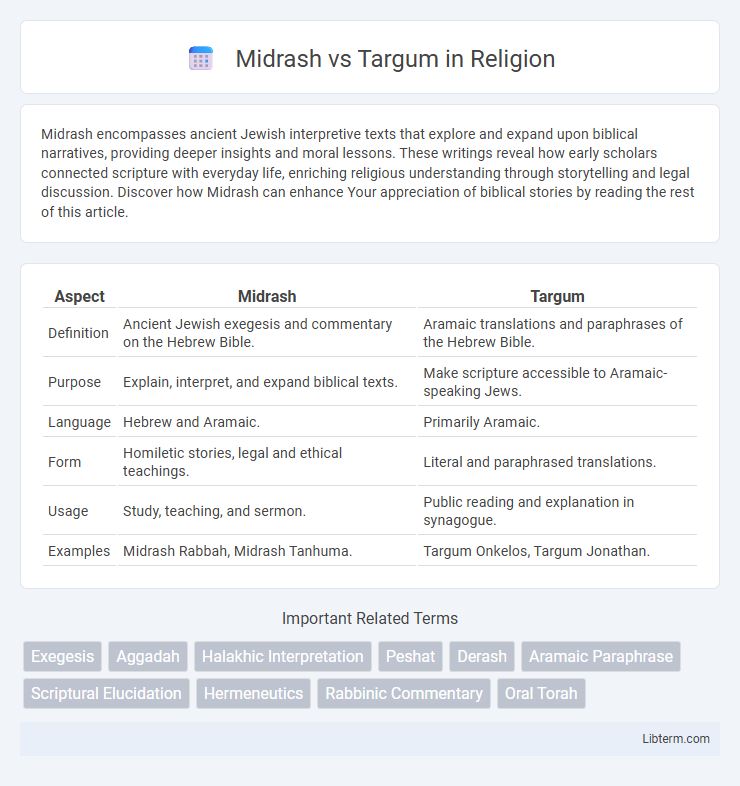Midrash encompasses ancient Jewish interpretive texts that explore and expand upon biblical narratives, providing deeper insights and moral lessons. These writings reveal how early scholars connected scripture with everyday life, enriching religious understanding through storytelling and legal discussion. Discover how Midrash can enhance Your appreciation of biblical stories by reading the rest of this article.
Table of Comparison
| Aspect | Midrash | Targum |
|---|---|---|
| Definition | Ancient Jewish exegesis and commentary on the Hebrew Bible. | Aramaic translations and paraphrases of the Hebrew Bible. |
| Purpose | Explain, interpret, and expand biblical texts. | Make scripture accessible to Aramaic-speaking Jews. |
| Language | Hebrew and Aramaic. | Primarily Aramaic. |
| Form | Homiletic stories, legal and ethical teachings. | Literal and paraphrased translations. |
| Usage | Study, teaching, and sermon. | Public reading and explanation in synagogue. |
| Examples | Midrash Rabbah, Midrash Tanhuma. | Targum Onkelos, Targum Jonathan. |
Introduction to Midrash and Targum
Midrash is a classical Jewish exegesis method that interprets biblical texts through storytelling, legal discussions, and ethical teachings, aiming to uncover deeper meanings beyond the literal text. Targum refers to Aramaic translations and paraphrases of the Hebrew Bible, which were used to make the scriptures accessible to Jewish communities familiar with Aramaic during the Second Temple period and thereafter. Both Midrash and Targum serve as vital tools in Jewish tradition for expanding understanding and preserving scriptural teachings.
Historical Origins and Development
Midrash and Targum both originated in the early Jewish diaspora as interpretative tools to preserve and transmit biblical texts amid linguistic and cultural changes. Midrash developed around the 2nd century CE as a method of homiletic and legal exegesis, expanding biblical narratives through rabbinic storytelling and theological insights. Targum emerged simultaneously as Aramaic translations of Hebrew scriptures, facilitating comprehension by Jewish communities whose primary language had shifted to Aramaic during the Second Temple period and beyond.
Defining Midrash: Purpose and Methodology
Midrash serves as a method of biblical exegesis that seeks to uncover deeper meanings, ethical lessons, and legal principles embedded in the Hebrew Scriptures through interpretative storytelling and commentary. Its methodology involves creative expansions and allegorical interpretations that connect scriptural verses to contemporary life, often filling narrative gaps or resolving textual ambiguities. This contrasts with Targum, which primarily functions as an Aramaic translation aimed at clarifying the biblical text for synagogue reading without extensive interpretative elaboration.
Understanding Targum: Function and Language
Targum serves as an essential Aramaic translation and interpretation of the Hebrew Bible, facilitating comprehension among Jewish communities during the Second Temple period and beyond. Its language blends colloquial Aramaic with exegetical expansions, aiming to clarify difficult biblical terms and concepts while preserving theological nuances. Targum functions both as a linguistic bridge and a didactic tool, enabling deeper engagement with sacred texts through accessible vernacular expression.
Literary Structures: Comparing Textual Styles
Midrash features expansive narrative expansions and homiletic interpretations that emphasize moral and theological lessons through parables and allegories, often presenting multiple layers of meaning within complex storytelling. Targum adopts a more systematic approach, offering a relatively direct Aramaic translation of Hebrew scriptures while incorporating clarifications and interpretive elements, maintaining a close correspondence to the original text's structure. The literary style of Midrash is fluid and discursive, contrasting with the concise and explanatory style characteristic of Targum, reflecting their distinct functions in Jewish textual tradition.
Role in Jewish Tradition and Worship
Midrash serves as a foundational source of Jewish law, ethics, and theology by providing interpretive narratives that expand biblical texts, enriching Jewish worship with moral and spiritual insights. Targum functions as an essential tool for communal prayer and study by translating the Hebrew Bible into Aramaic, ensuring accessibility and comprehension during synagogue services. Both Midrash and Targum play complementary roles in Jewish tradition, with Midrash offering exegetical elaboration and Targum facilitating liturgical engagement.
Key Differences in Interpretation
Midrash emphasizes expansive narrative and legal explanations, using creative storytelling to explore biblical texts, while Targum provides direct, often literal translations and paraphrases of the Hebrew Bible into Aramaic for accessibility. Midrash interprets underlying ethical meanings and theological concepts, offering homiletical insights, whereas Targum aims to clarify and make scripture comprehensible during synagogue readings. The distinction lies in Midrash's interpretative depth and thematic elaboration versus Targum's functional role as a linguistic bridge.
Influence on Later Jewish Thought
Midrash and Targum significantly shaped later Jewish thought by providing interpretative frameworks that deepened the understanding of biblical texts. Midrash offered expansive narrative and legal insights, influencing rabbinic legislation and ethical teachings, while Targum preserved Aramaic translations that became essential for scriptural study and liturgical use. Together, they fostered a dynamic tradition of exegesis that continues to impact Jewish theology, law, and cultural identity.
Major Examples of Midrashim and Targumim
Major examples of Midrashim include Midrash Rabbah, which contains expansive rabbinic commentaries on the Pentateuch and the Five Megillot, and Midrash Tehillim, focusing on the Psalms. Prominent Targumim consist of Targum Onkelos, the official Aramaic translation of the Torah, and Targum Jonathan, translating the Nevi'im (Prophets). Both Midrashim and Targumim play critical roles in Jewish exegetical tradition, with Midrashim emphasizing homiletic interpretation and Targumim serving as authoritative Aramaic translations.
Contemporary Relevance and Study
Midrash and Targum both serve as vital interpretative tools in contemporary biblical studies, with Midrash offering expansive narrative and legal exegesis that enriches ethical and theological discourse. Targum provides accessible translations and paraphrases of Hebrew Scriptures in Aramaic, supporting deeper understanding for communities engaging with ancient texts in modern contexts. Scholars utilize Midrash to explore layered meanings and Targum to trace linguistic evolution, highlighting their ongoing relevance in academic and religious education.
Midrash Infographic

 libterm.com
libterm.com